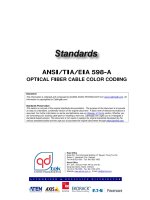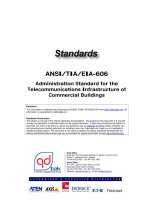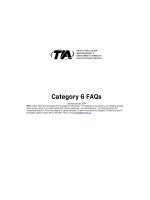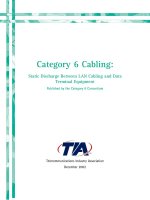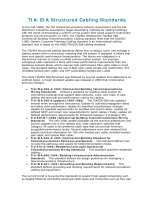Tài liệu Cabling Standard - TIA - Cat 6 FAQ docx
Bạn đang xem bản rút gọn của tài liệu. Xem và tải ngay bản đầy đủ của tài liệu tại đây (191.18 KB, 9 trang )
Category 6 FAQs
Updated January 2004
Note: These FAQs were developed by the Category 6 Consortium. The Category 6 Consortium is an emerging working
group whose mission is to create market and industry awareness - as well as demand - for cabling systems and
components based on TIA's new category 6 cabling standard. To learn more about the Category 6 Consortium and to
participate, please contact TIA at (703) 907-7723 or email
.
Category 6 Cable Questions
1. What is the difference between enhanced category 5e cable rated for 400 MHz
and category 6 cable rated for 250 MHz?
Category 5e requirements are specified up to 100 MHz. Cables can be tested up to any
frequency that is supported by the test equipment, but such measurements are
meaningless without the context of applications and cabling standards. The Category 6
standard sets minimum requirements up to 250 MHz for cables, connecting hardware,
patch cords, channels and permanent links, and therefore guarantees reasonable
performance that can be utilized by applications.
2. Why did all category 6 cable used to have a spline, and now is offered without
one?
Some Category 6 cable designs have a spline to increase the separation between pairs
and also to maintain the pair geometry. This additional separation improves NEXT
performance and allows Category 6 compliance to be achieved. With advances in
technology, manufacturers have found other ways of meeting Category 6 requirements.
The bottom line is the internal construction of the cable does not matter, so long as it
meets all the transmission and physical requirements of Category 6. The standard does
not dictate any particular method of cable construction.
3. Is there a limitation on the size of bundles one can have with category 6? Can
you have 200-300 and still pass category 6?
There is no limit imposed by the standards on the maximum number of Category 6 cables
in a bundle. This is a matter for the market and the industry to determine based on
practical considerations. It should be pointed out that after six or eight cables, the
performance in any cable will not change significantly since the cables will be too far away
to add any additional external (or alien) NEXT.
4.
If we use a Cat 5e RJ45 connector and connect it to a Cat 6 UTP cable, will
the installation be Cat5e or Cat 6?
By definition (of the standard), it will be a Cat 5e channel. The actual performance will
probably be somewhat better, but nowhere near Cat 6 requirements. Of course, you can
set up a channel using any components and measure it using a Cat 6 (level III) compliant
tester, and if it passes, it is Cat 6 performance compliant. It would not be standards
compliant however, because the components have requirements in and of themselves to
assure interoperability with other Cat 6 components.
5.
I am receiving a lot of questions about a multipair Cat 6, is any
specification available for this cable? Does it exist?
Multipair cables are not specifically called out in ANSI/TIA-568-B.2-1, the Category 6
standard. See section 6.1.2 below which recognizes 4-pair cables for backbone
applications. Additionally, hybrid cables consisting of multiple 4-pair cables in a single
jacket or binder may also be used for both horizontal and backbone applications provided
that the requirements of section 6.1.3 below are met. Since Category 6 cabling is based
on a 4-pair, 4-connector, 100 meter channel, multipair cables are implemented as hybrid
cables consisting of 4-pair sub-units.
5.1.2. Backbone cable section, ANSI/TIA-568-B.2-1 Category 6 standard.
Four-pair 100. UTP and ScTP cables are recognized for use in Category 6
backbone cabling systems. The cable shall consist of 22 AWG to 24 AWG
thermoplastic insulated solid conductors that are formed into four individually
twisted-pairs and enclosed by a thermoplastic jacket. The cable shall meet all of
the mechanical requirements of ANSI/ICEA S-80-576 applicable to four-pair inside
wiring cable for plenum or general cabling within a building. In addition to the
applicable requirements of ANSI/ICEA S-90-661-1994, the physical design of
backbone cables shall meet the requirements of clauses 4.4.3.1 to 4.4.3.6 of
ANSI/TIA/EIA -568-B.2. NOTE: Additional requirements for 100 ScTP cables are
located in annex K of ANSI/TIA/EIA-568-B.2.
5.1.3 Bundled and hybrid cable, ANSI/TIA-568-B.2-1 Category 6 standard.
Bundled and hybrid cables may be used for horizontal and backbone cabling
provided that each cable type is recognized (see clause 6.1.1 of this standard and
clause 4.4 of ANSI/TIA/EIA-568-B.1) and meets the transmission and color-code
specifications for that cable type as given in ANSI/TIA/EIA-568-B.2,
ANSI/TIA/EIA-568-B.3, and clause 7 of this standard. Additionally, for all
frequencies from 1 MHz to 250 MHz, the total power sum NEXT loss for any
disturbed pair from all pairs internal and external to that pair's jacket within the
bundled or hybrid cable shall not exceed the values determined using equation
(1). Calculated power sum NEXT loss limit values that exceed 65 dB shall revert to
a limit of 65 dB.
Category 6 Cabling System and Application Questions
6. Why do I need all the bandwidth of category 6? As far as I know, there is no
application today that requires 200 MHz of bandwidth.
Bandwidth precedes data rates just as highways come before traffic. Doubling the
bandwidth is like adding twice the number of lanes on a highway. The trends of the past
and the predictions for the future indicate that data rates have been doubling every 18
months. Current applications running at 1 Gb/s are really pushing the limits of Category 5e
cabling. As streaming media applications such as video and multi-media become
commonplace, the demands for faster data rates will increase and spawn new applications
that will benefit from the higher bandwidth offered by Category 6. This is exactly what
happened in the early ’90s when the higher bandwidth of Category 5 cabling compared to
Category 3 caused most local area network (LAN) applications to choose the better media
to allow simpler, cost effective, higher speed LAN applications, such as 100BASE-TX. It is
also important to note that cabling infrastructure is generally considered a 10 year
investment as opposed to two or three years for electronics. Work has already started on
10G BASE-T, and Category 5e cabling is not being considered. With additional throughput
requirements right around the corner, it makes sense to plan ahead.
Note: Bandwidth is
defined as the highest frequency up to which positive power sum ACR (attenuation-to-
crosstalk ratio) is greater than zero.
7. What is the general difference between category 5e and category 6?
The general difference between Category 5e and Category 6 is in the transmission
performance and extension of the available bandwidth from 100 MHz for Category 5e to
200 MHz for Category 6. This includes better insertion loss, near end crosstalk (NEXT),
return loss and equal level far end crosstalk (ELFEXT). These improvements provide a
higher signal-to-noise ratio, allowing higher reliability for current applications and higher
data rates for future applications. The additional performance parameters provide a sort of
"forgiveness factor" for things that happen within a cabling infrastructure over its lifetime
assuring that bandwidth remains available for applications. Please note that the bandwidth
referred to above is the bandwidth to achieve a positive signal to noise ratio between
insertion loss and power sum near end crosstalk (PSACR is greater than 0). Cat 6 cabling
performance is specified to 250 MHz, or 25 percent beyond the 0 dB PSACR frequency of
200 MHz.
8. Will category 6 supersede category 5e?
Yes, analyst predictions and independent polls indicate that 80 to 90 percent of all new
installations will be cabled with Category 6. The fact that Category 6 link and channel
requirements are backward compatible to Category 5e makes it very easy for customers to
choose Category 6 and supersede Category 5e in their networks. Applications that worked
over Category 5e will work over Category 6.
9. What does category 6 do for my current network vs. category 5e?
Because of its improved transmission performance and superior immunity from external
noise, systems operating over Category 6 cabling will have fewer errors vs. Category 5e
for current applications. This means fewer re-transmissions of lost or corrupted data
packets under certain conditions, which translates into higher reliability for Category 6
networks compared to Category 5e networks.
10.
I understand that a Cat 5e connector is an RJ45. Is a Cat 6 connector also
an RJ45 and will it fit into our Cat 5e socket?
The standard connector is defined in IEC 603-7 and FCC part 68 as an "8 position modular
interface." This is commonly referred to as an RJ-45 in the United States. The interface is
required by the standard at the telecommunications outlet, but may be used at any
connection point in the channel. The physical dimensions of the Cat 6 connector interface
are identical to Cat 3, Cat 5, and Cat 5e modular connectors and are fully backward
compatible.
11. When should I recommend or install category 6 vs. category 5e?
From a future proofing perspective, it is always better to install the best cabling available.
This is because it is so difficult to replace cabling inside walls, in ducts under floors and
other difficult places to access. The rationale is that cabling will last at least 10 years and
will support at least four to five generations of equipment during that time. If future
equipment running at much higher data rates requires better cabling, it will be very
expensive to pull out Category 5e cabling at a later time to install Category 6 cabling. So
why not do it for a premium of about 20 percent over Category 5e on an installed basis?
12. What is the shortest link that the standard will allow?
There is no short length limit. The standard is intended to work for all lengths up to 100
meters. There is a guideline in ANSI/TIA/EIA-568-B.1
that says the consolidation point
should be located at least 15 meters away from the telecommunications room to reduce
the effect of connectors in close proximity. This recommendation is based upon worst-
case performance calculations for short links with four mated connections in the channel.
13. What is a “tuned” system between cable and hardware? Is this really needed if
product meets the standard?
The word "tuned" has been used by several manufacturers to describe products that
deliver headroom to the Category 6 standard. This is outside the scope of the Category 6
standard. The component requirements of the standard have been carefully designed and
analyzed to assure channel compliance and electrical/mechanical interoperability.
14. What is impedance matching between cable and hardware? Is this really
needed if product meets the standard?
The impedance matching requirements of the standard are addressed by having return
loss requirements for cables, connectors and patch cords.
15. Is there a use for category 6 in the residential market?
Yes, Category 6 will be very effective in the residential market to support higher Internet
access speeds while facilitating the more stringent Class B EMC requirements
(see also the
entire FCC Rules and Regulations, Title 47, Part 15
). The better balance of Category 6 will
make it easier to meet the residential EMC requirements compared to Category 5e cabling.
Also, the growth of streaming media applications to the home will increase the need for
higher data rates which are supported more easily and efficiently by Category 6 cabling.
16. Why wouldn’t I skip category 6 and go straight to optical fiber?
You can certainly do that, but you will find that a fiber system is still very expensive.
Ultimately, economics drive customer decisions, and today optical fiber together with
optical transceivers is about twice as expensive as an equivalent system built using
Category 6 and associated copper electronics. Installation of copper cabling is more craft-
friendly and can be accomplished with simple tools and techniques. Additionally, copper
cabling supports the data terminal equipment (DTE) power standard developed by IEEE
(802.3af
). PCs ship with copper network interfaces included, in fact, recent
announcements indicate that the major PC vendors are shipping 10/100/1000 with all new
systems. Moving to fiber would mean buying a fiber-based network card to replace
equipment already included in the PC.
17.
We have a Category 6 installation in a campus dormitory environment and
recently discovered that several horizontal runs exceed 295 feet.
The application is 10/100 access from the dormitory room to the Internet. For those
locations beyond the 295 feet, we found the only workable solution is for the PCs to run
10Mbps 1/2 duplex.
18. What is meant by the term "electrically balanced"?
A simple open wire circuit consisting of two wires is considered to be a uniform, balanced
transmission line. A uniform transmission line is one that has substantially identical
electrical properties throughout its length, while a balanced transmission line is one whose
two conductors are electrically alike and symmetrical with respect to ground and other
nearby conductors.
* "Electrically balanced" relates to the physical geometry and the dielectric properties of a
twisted pair of conductors. If two insulated conductors are physically identical to one
